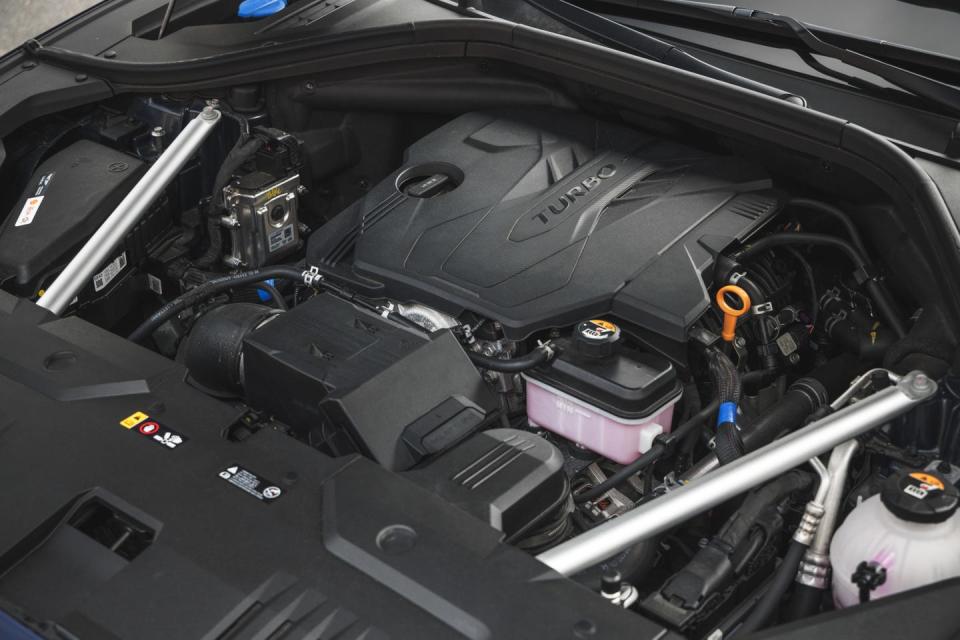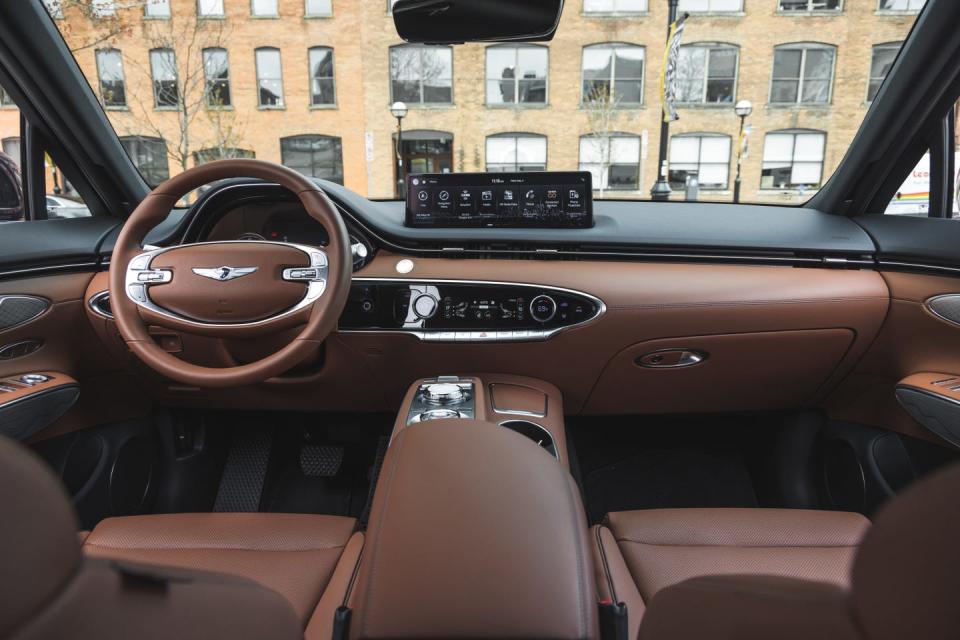Tested: 2022 Genesis GV70 2.5T Follows Close behind the 3.5T

We've been mighty impressed with the Genesis GV70. The compact SUV just vanquished the BMW X3 and the Lexus RX in a comparison test, and we've welcomed a GV70 for a long-term test to see how it stacks up over 40,000 miles. Both of those examples, as well as the one we drove for our initial review, are the six-cylinder 3.5T model. But what about the four-cylinder variant? Turns out, the entry-level GV70 gives up little to its more powerful sibling.
The 2.5T employs a turbocharged 2.5-liter four that also serves in other Genesis models, as well as the Hyundai Sonata N Line, Kia K5 GT, and Kia Sorrento. Here, it makes 300 horsepower and 311 pound-feet of torque, the latter over a broad rev range of 1650 to 4000 rpm. That's a good bit less than the 375 horses and 391 pound-feet from the 3.5T's twin-turbo V-6, but it's a strong showing for a turbo four. As in the GV70 3.5T, an eight-speed automatic handles the shifting duties, and all-wheel drive is standard. However, the six-cylinder's available limited-slip rear differential can't be had here.

The turbo four's 75-pony deficit relative to the twin-turbo V-6 adds 1.0 second to its 60-mph sprint, with the 2.5T completing the dash in 5.6 seconds. That puts it neck and neck with the Audi Q5 45 (5.5 seconds) yet well ahead of both the Volvo XC60 B6 (6.6 seconds) and the BMW X3 30i (6.1 seconds). It also hustles through the quarter-mile in 14.1 seconds at 99 mph, against 13.3 and 104 mph for the six-cylinder version.
Away from the test track, we found the base powertrain to have plenty of urge. It's mostly well polished in its response, with only the faintest surging in light throttle applications over rolling terrain. The eight-speed automatic generally impresses with its invisibility and is a better teammate to this turbo four than is the eight-speed dual-clutch gearbox that Hyundai and Kia pair with this engine.

Like the twin-turbo V-6, the turbocharged four-cylinder can deliver its electronically enhanced engine sound in a choice of three volume levels—but that sound is not as endearing as the six's. Choose the quietest, and the GV70 2.5T is hushed indeed. We measured a mere 65 decibels at a 70-mph cruise—significantly quieter than its G70 sedan sibling—and 73 decibels at wide-open throttle. Both those results are quieter than the 3.5T's, and that cruising noise level even beats six-figure big rigs such as the Cadillac Escalade, Lincoln Navigator, and Lexus LX600.
Stops from 70 mph take a somewhat long 177 feet; that's better than the 180-foot result we got in initial testing of our long-term 3.5T but not as good as the X3's 175 feet or the XC60's 164 feet. Both GV70 models allow the driver to adjust brake-pedal response, but we had a hard time discerning much of a difference between each car's two settings.

As you'd expect, EPA fuel economy for the four-cylinder GV70 is better than with the 3.5T. EPA estimates of 22 mpg city/28 highway match or are within 1 mpg of the figures for the X3 xDrive, XC60, Q5, and Infiniti QX50. Opting for the 21-inch wheels, however, drags down the city figure by a whopping 3 mpg and the highway number by 2 mpg, putting it almost on par with the V-6 version. Our Advanced-trim-level test car was fitted with 19s, and in our 75-mph highway fuel-economy test we exactly matched the EPA's 28 mpg. That's a significant 5 mpg better than we saw in the same test with the 3.5T.
Like the 3.5T, the 2.5T has Eco, Comfort, Sport, Sport+, and Custom drive modes. Here, they don't affect the suspension (adaptive dampers are exclusive to the V-6) but do somewhat alter the character of the steering, transmission, engine sound, and brakes. The extensive adjustability is of limited value. The Sport mode's heavier steering really isn't preferable with the standard setup. And that setting's shift mapping is good if you're going to attack a spate of twisties, but its reluctance to upshift when just cruising will prevent most drivers from leaving the car in that mode.


 Yahoo Autos
Yahoo Autos 